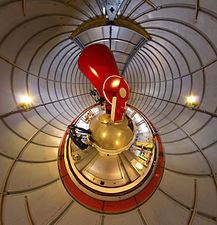Organisation Observatory of Geneva First light 12 April 1998 Diameter 1.2 m (3 ft 11 in) | ||
 | ||
Location(s) La Silla Observatory , Chile | ||
Leonhard Euler Telescope, or the Swiss EULER Telescope, is a national, fully automatic 1.2-metre (3.9 ft) reflecting telescope, built and operated by the Geneva Observatory. It is located at an altitude of 2,375 m (7,792 ft) at ESO's La Silla Observatory site in the Chilean Norte Chico region, about 460 kilometers north of Santiago de Chile. The telescope, which saw its first light on 12 April 1998, is named after Swiss mathematician Leonhard Paul Euler.
Contents
The Euler telescope uses the CORALIE instrument to search for exoplanets. In addition, the telescope uses the multi-purpose EulerCam (ecam), a high precision photometry instrument, and a smaller, piggyback mounted telescope, called "Pisco". Its first discovery was a planet in orbit around Gliese 86, determined to be a hot Jupiter with an orbital period of only 15.8 earth days and about four times the mass of Jupiter. Since then, many other exoplanets have been discovered or examined in follow-up observations.
Together with the Mercator Telescope, Euler was part of the Southern Sky extrasolar Planet search Programme, which has discovered numerous extrasolar planets. It has also been frequently employed for follow-up characterization to determine the mass of exoplanets discovered by the Wide Angle Search for Planets, SuperWASP.
Instruments
The CORALIE spectrograph is an echelle type spectrograph used for astronomy and was commissioned at the Euler Telescope in April 1998. The instrument performs doppler spectroscopy, that is it measures the Doppler effect on a star's electromagnetic spectrum caused by the gravitational tug of an exoplanet orbiting around it. The spectrograph participates in the Southern Sky extrasolar Planet search Programme.
Doppler spectroscopy, also known as "radial velocity" or "wobble" method, is an indirect detection method as it only observes the star's spectrum and not the planet itself. It differs from the transit method used by the space-based Kepler mission and ground-based SuperWASP and Next-Generation Transit Survey and can therefore be complementary to their observations. This is because the size of an exoplanet can be estimated using the transit method, while Doppler spectroscopy is used to estimate its mass. By combining the measured size and mass from both methods, it can be determined whether the observed exoplanet is gaseous or rocky.
The ELODIE spectrograph was a device similar to CORALIE
Characteristics
The resolution of CORALIE is fixed at R = 50,000 with a 3 pixel sampling. The detector CCD is 2k X 2k with a 15 micrometer pixel size.
Discovered exoplanets
Five planetary object have been discovered using CORALIE along with several confirmations of discoveries by other programs.
